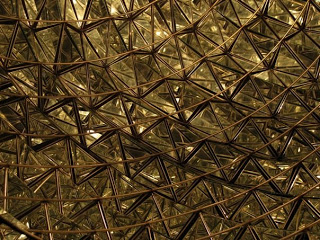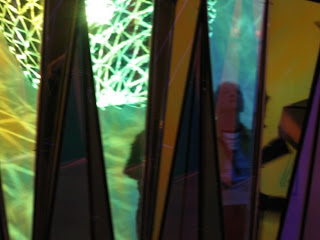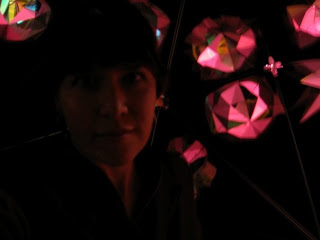Olafur Eliasson
Art Vent Letting the Fresh Air In
Which comes first, the artist or the landscape? I remember being profoundly disappointed when I went to Aix-en-Provence and discovered that the countryside looked exactly like a Cezanne. Damn! He just painted what was in front of him--although he did elaborate a bit on Mount St. Victoire, which was punier than I expected. And Venice looks just like Canaletto, Paris like that rainy day Caillebotte at the Art Institute in Chicago I've always loved, and while I haven't been to China, a friend told me that the mountains and mist look just like--Chinese paintings. So now that I live on the edge of the Hudson River Valley I think a lot about the painters of the Hudson River School and how they, too, were painting just what was in front of them. Or were they? Perhaps I see it the way I see it because I've been shown it through their eyes.
I thought about this a lot on our trip to
I get annoyed when people apologize for photographs, but this is the best I have of the cliff line with waterfalls at Þingvellir, taken around 11:00 at night with an overcast sky. At least you get the idea. I haven't yet got the hang of taking photographs in Iceland, but it's something I look forward to working on.
Readers of this blog know how passionate I am about keeping the art experience free from any interference that attempts to interpret the work for viewers or bombard them with information that gives the impression that art is about, well, information. This is a philosophy I share with Robert Irwin and Olafur, who was greatly influenced by Irwin (did I get the idea from them or was I attracted to them because of it?—another question that can never be answered). No wonder I’m so comfortable in
The only sign I saw at Gulfoss, one of the biggest waterfalls in Iceland. The cloverleaf symbol indicates an official site of natural or historic interest.
And now I’m off to
 I am proud of my garden but all I did was put in some seeds and keep the weeds out. I find it difficult to take credit for nature.
I am proud of my garden but all I did was put in some seeds and keep the weeds out. I find it difficult to take credit for nature.

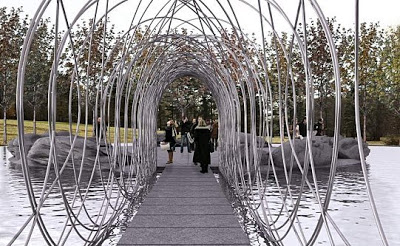

Middle photo: Photo: Olafur Eliasson Studio
The latticework pattern mimics that of the ripples in the pond. Did he know it would do that?


The Eliasson installation is adjacent to the Frank Gehry designed Fisher Center for the Performing Arts, a building I love for its quality of lightness and insubstantiality, heightened on this overcast day so that the roof of the building seemed to merge with the sky.


Sadly, this lyrical dance of wing-like curves and light ends abruptly with the rear of the building, which is as square and clunky as the back of any urban theater. Although I've been to the Fisher Center several times, I'm never prepared for the nasty slap of reality that awaits me as I walk around it to my parked car. I want to believe in the fairy tale.

I thought Art Chicago was pretty boring—only a handful of really good galleries represented—but, to my surprise, loved the Antiques Fair a few floors below. Meanwhile the Olafur Eliasson exhibition at the MCA (through September 13th) has caused a lot of excitement—as I mentioned, so much better than at MoMA and PS 1—and the the pairing with the Buckminster Fuller show (through August 9th) is genius, because you can see the lineage. As I’ve no doubt mentioned before, Einar Thorsteinn, who works with Olafur (“helps me with models and helps me to think,” as Olafur said in his artist’s talk), was a protégé of Fuller, and so here you can look at Fuller’s models and then go downstairs and see how Olafur and Einar have taken off on them in their own models, made them more fanciful, and then elaborated on them in large works. There are also interpretations of Fuller’s work by sculptor Kenneth Snelson, which are gorgeous. I wish I had images to illustrate all of this, but I was only able to photograph Eliasson’s exhibition while accompanied by a representative of the MCA, and had not made an appointment to shoot the Fuller show.
Let me go off a little bit on this policy of no photography, which is shared by the Whitney (but not by MoMA), and the reason I didn’t write about Jenny Holzer’s show here, which I loved. Yes, I could have gotten images from the museum, but if they didn’t reflect my vision, I’d just be doing P.R. I could understand it in the old days, the concern that a lousy shot taken on someone’s Brownie could end up in a magazine as representative of the artist’s work, or that people would produce coffee mugs and T-shirts with a pirated image. But today, when the influence of print is lessening and word-of-mouth rules, why would you want to insist on stopping someone from taking a picture with her iPhone and emailing her excitement to all of her friends? As for artists, photography is a way of recording what is important to them—not some commercial photographer—ideas that they may want to incorporate into their own work. As we all know, major museum exhibitions have an influence on the art that comes after, and to limit that in any way seems counter-productive.
 Museums seem to be catering more and more to the casual visitor while distancing themselves from artists. First there’s the entrance fee, which limits when you can see the work (in crowds on free night). I tried to get a friend who’s a professor of art in Iowa into MoMA on my press card with me, and was told she could come in for free if she had a group of students with her. But even if she were teaching in New York, doesn’t she have to see the show first, to decide if it’s something she wants to bring her students to? I know so many artists who choose to pass on major exhibitions because of the fee, and often if you find a good show, you want to see it more than once. In Chicago, no doubt, many artists can afford to join both the MCA and the Art Institute (or “INSTITVTE” as it reads on their Web site—yikes!), but in New York, with a plethora of major museums, cost becomes prohibitive. I propose that the New York museums get together on an “artist’s card” that would allow entrance to all the museums for a yearly fee of $125 or so. Verifying that someone is an artist is easier now than it was back in the day when I had to prove my professional status to the city in order to live in SoHo—it can be anyone who has a Web site featuring their work, or is featured on a gallery Web site. Such a policy would increase not only traffic but word-of-mouth.
Museums seem to be catering more and more to the casual visitor while distancing themselves from artists. First there’s the entrance fee, which limits when you can see the work (in crowds on free night). I tried to get a friend who’s a professor of art in Iowa into MoMA on my press card with me, and was told she could come in for free if she had a group of students with her. But even if she were teaching in New York, doesn’t she have to see the show first, to decide if it’s something she wants to bring her students to? I know so many artists who choose to pass on major exhibitions because of the fee, and often if you find a good show, you want to see it more than once. In Chicago, no doubt, many artists can afford to join both the MCA and the Art Institute (or “INSTITVTE” as it reads on their Web site—yikes!), but in New York, with a plethora of major museums, cost becomes prohibitive. I propose that the New York museums get together on an “artist’s card” that would allow entrance to all the museums for a yearly fee of $125 or so. Verifying that someone is an artist is easier now than it was back in the day when I had to prove my professional status to the city in order to live in SoHo—it can be anyone who has a Web site featuring their work, or is featured on a gallery Web site. Such a policy would increase not only traffic but word-of-mouth.That said, here are some random shots from the Eliasson exhibition:

 Your eye activity field, 2009, oil on canvas (detail). Created for the MCA's lobby and atrium, this series of 300 canvases (approximately 6" x 14") represents the 300 nanometers of the color spectrum that can be seen by the human eye
Your eye activity field, 2009, oil on canvas (detail). Created for the MCA's lobby and atrium, this series of 300 canvases (approximately 6" x 14") represents the 300 nanometers of the color spectrum that can be seen by the human eye Reimagine, 2002: spotlights cast shiftin, overlapping rectalinear patters across the gallery wall, creating an illusion of distance and depth.
Reimagine, 2002: spotlights cast shiftin, overlapping rectalinear patters across the gallery wall, creating an illusion of distance and depth. Beauty, 1993: a spotlight shining obliquely through a curtain of fine mist.
Beauty, 1993: a spotlight shining obliquely through a curtain of fine mist. From the model room
From the model room
 One-way colour tunnel (detail) with view of Inverted Berlin sphere, 2005
One-way colour tunnel (detail) with view of Inverted Berlin sphere, 2005
 Colour sphere embracer, 2005, colored glass rings suspended from the ceiling nestle inside one another while a motor simultaneously rotates each in a different direction.
Colour sphere embracer, 2005, colored glass rings suspended from the ceiling nestle inside one another while a motor simultaneously rotates each in a different direction.When Buckminster Fuller visited Reykjavik two years later, Einar told him this story. “I’m happy to know this,” Bucky said, “because I like to think that everyone has some good in them and I’ve never heard anything positive about Nixon.”
Einar writes about this, his first visit with Fuller, in his upcoming book about his 40-year quest to find what he has named the “Fang,” which is, in geometric terms “a space-filler for five-fold symmetry space.” Below, Einar’s geometry at work in one of Olafur Eliasson’s installations, Your spiral view (2002), which I photographed at the Kunstmuseum in Wolfsburg, Germany, in 2004, and is now part of the Beyeler Foundation collection.
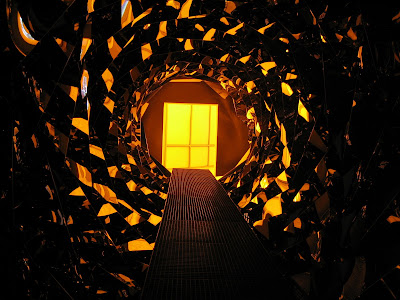
Einar's studio:




 The office:
The office:
The living room:

The dining area:

Einar at work:


I’d hoped that my ten days away just before the election would provide some much-needed respite from agonizing over it every single moment, but instead I found the Europeans equally obsessed. To judge by the amount of coverage the election is getting in the British press, you’d think it was a local event. And the international members of Olafur Eliasson’s staff, who I joined for lunch in his Berlin studio, were as up-to-date on Joe the Plumber and the price of Sarah Palin’s wardrobe as anyone. It feels as if the whole world is holding its breath.
There’s even a Web site started by three Icelanders, If the World Could Vote, which (as of this writing) has collected 666,246 symbolic votes from 210 countries: 578,461 (86.8%) for Obama, 87,780 (13.2%) for McCain. I’d feel better if the polls reflected a similar disparity.
Our purpose in going to Olafur’s studio was to shoot footage for a short documentary focusing on his collaboration with mathematician, architect, and all-around visionary Einar Thorsteinn, who previously worked with Buckminster Fuller and Linus Pauling. Olafur and Einar have been working together since they met in Iceland 12 years ago, when Olafur, then 29, was looking for someone to help him build a geodesic dome-type structure, and one project led to another. The two-hour shoot couldn’t have gone better. We had some anxiety when, in the morning, city workers suddenly appeared with deafeningly noisy equipment to spend several hours pounding gravel into the cobblestone courtyard outside, but miraculously they finished just as we were about begin. I barely had to refer to my list of prepared questions; Olafur and Einar addressed each point in order as methodically as if they’d been clued in by a secret spy (I believe in never sharing questions with interviewees in advance, lest I get a canned response).
 Despite requests by collectors and institutions to buy individual models and even the whole, Olafur and Einar’s Model Room, much of which was at PS 1 for the MoMA show, has been reinstalled in the conference room of the new studio and spills out into the hallway, where it continues to grow and serve as inspiration for new projects. The attitude toward it is hardly precious—this is a workshop, Einar said—and he told us, while we were filming it, to feel free to move things around as we liked. While Terry and Erica were setting up, I had time to spend with these quirky geometric gems, which led me to think about the relationship between harmony and chaos and how, to be fully engaging, an artwork requires certain degrees of each. It was also energizing to be around the 30 or 40 members of Olafur’s busy team, who he sees as working with rather than for him, acknowledged co-creators, an attitude which results in a palpable enthusiasm all around. He also feeds them well. Every day the cook (working in the studio kitchen, which is not walled off, so that she’s part of the creative bustle around her) prepares a simple, healthy lunch—the day I was there it was pumpkin risotto with a green salad and great bread. The food is is laid out buffet style and eaten on long trestle tables in the cavernous dining area, which has walls and high ceilings faced with the remnants of beautiful old tiles and tall, arched windows. As well as making sure everyone gets proper nutrition, the communal meal has its practical reasons for being—no one wastes time going out for food, and it provides a daily opportunity for cross-communication that would be unlikely otherwise.
Despite requests by collectors and institutions to buy individual models and even the whole, Olafur and Einar’s Model Room, much of which was at PS 1 for the MoMA show, has been reinstalled in the conference room of the new studio and spills out into the hallway, where it continues to grow and serve as inspiration for new projects. The attitude toward it is hardly precious—this is a workshop, Einar said—and he told us, while we were filming it, to feel free to move things around as we liked. While Terry and Erica were setting up, I had time to spend with these quirky geometric gems, which led me to think about the relationship between harmony and chaos and how, to be fully engaging, an artwork requires certain degrees of each. It was also energizing to be around the 30 or 40 members of Olafur’s busy team, who he sees as working with rather than for him, acknowledged co-creators, an attitude which results in a palpable enthusiasm all around. He also feeds them well. Every day the cook (working in the studio kitchen, which is not walled off, so that she’s part of the creative bustle around her) prepares a simple, healthy lunch—the day I was there it was pumpkin risotto with a green salad and great bread. The food is is laid out buffet style and eaten on long trestle tables in the cavernous dining area, which has walls and high ceilings faced with the remnants of beautiful old tiles and tall, arched windows. As well as making sure everyone gets proper nutrition, the communal meal has its practical reasons for being—no one wastes time going out for food, and it provides a daily opportunity for cross-communication that would be unlikely otherwise.

 The 30,000 SF building, which the studio only recently moved in to, is a red brick fortress-like former brewery, and when Einar told me about it last year, referring to it as Olafur’s “castle in the center of Berlin,” I didn’t know that he was being so literal. The first floor is the kitchen, workshop and showroom (in the old studio, one worker told me, there was no room even to set things up and see how they looked), the second is the conference room and studio, and the top floor will house a school for 15-20 students (best described in this That experience, coupled with a visit to Einar and Manuela’s home in the Berlin outskirts, a house which nearly bursts with the results of their combined creativity (the subject of the next Art Vent House Report), made me want to just come home and work. The best possible outcome.
The 30,000 SF building, which the studio only recently moved in to, is a red brick fortress-like former brewery, and when Einar told me about it last year, referring to it as Olafur’s “castle in the center of Berlin,” I didn’t know that he was being so literal. The first floor is the kitchen, workshop and showroom (in the old studio, one worker told me, there was no room even to set things up and see how they looked), the second is the conference room and studio, and the top floor will house a school for 15-20 students (best described in this That experience, coupled with a visit to Einar and Manuela’s home in the Berlin outskirts, a house which nearly bursts with the results of their combined creativity (the subject of the next Art Vent House Report), made me want to just come home and work. The best possible outcome. I didn’t see much to mention in London, other than Frank Gehry’s pavilion at the Serpentine, which looked as if he’d handed the project over to an intern. Or perhaps it would have been better if he had. Terry deemed it “over-built and under-designed.” While the press release described it as “seemingly random,” I—a Gehry fan in general—couldn’t discern any over-arching concept, but saw it as an example of chaos that could have benefited from a little mediating harmony. I think we’ve had enough random for one century, thank you. While we were there an English girl and her Indian boy friend—art students, no doubt—were in the middle of an argument about their relationship when the guy became distracted and, looking over at the pavilion, muttered, “That thing is a pile of shit.”
 I did, however, get to spend quality time with the Upholstery Eater and am pleased to report that she’s thriving despite (or maybe because of) her inherited proclivity.
I did, however, get to spend quality time with the Upholstery Eater and am pleased to report that she’s thriving despite (or maybe because of) her inherited proclivity.

And I’m off to Europe early Tuesday morning for almost two weeks—to England and then Berlin to work (with Terry Perk and Erica Spizz) on a short film about Olafur Eliasson and Einar Thorsteinn’s collaborative process, funded by the University for the Creative Arts in the U.K. I don’t know if the trip will prompt more posts, fewer posts, or no posts, so bear with me. Cheerio!


 Olafur Eliasson and Einar Thorsteinn, details from The Model Room, as installed at PS 1 last spring,.
Olafur Eliasson and Einar Thorsteinn, details from The Model Room, as installed at PS 1 last spring,.

